Saturday 26 November 2016
Tuesday 4 October 2016
Wednesday 24 February 2016
What is Car Jack
CAR JACK
- The most common form is a car jack, floor jack or garage jack, which lifts vehicles so that maintenance can be performed.
- Jacks are usually rated for a maximum lifting capacity (for example, 1.5 tons or 3 tons).



Earth's Atmospheric Layers
Earth's Atmospheric Layers

Troposphere
The troposphere starts at the Earth's surface and extends 8 to 14.5 kilometers high (5 to 9 miles). This part of the atmosphere is the most dense. Almost all weather is in this region.
Stratosphere
Stratosphere
The stratosphere starts just above the troposphere and extends to 50 kilometers (31 miles) high. The ozone layer, which absorbs and scatters the solar ultraviolet radiation, is in this layer.

Mesosphere

Mesosphere
The mesosphere starts just above the stratosphere and extends to 85 kilometers (53 miles) high. Meteors burn up in this layer
Thermosphere
Thermosphere
The thermosphere starts just above the mesosphere and extends to 600 kilometers (372 miles) high. Aurora and satellites occur in this layer.
Ionosphere
Ionosphere
The ionosphere is an abundant layer of electrons and ionized atoms and molecules that stretches from about 48 kilometers (30 miles) above the surface to the edge of space at about 965 km (600 mi), overlapping into the mesosphere and thermosphere. This dynamic region grows and shrinks based on solar conditions and divides further into the sub-regions: D, E and F; based on what wavelength of solar radiation is absorbed. The ionosphere is a critical link in the chain of Sun-Earth interactions. This region is what makes radio communications possible.

Exosphere

Exosphere
This is the upper limit of our atmosphere. It extends from the top of the thermosphere up to 10,000 km (6,200 mi).
Monday 15 February 2016
What is Fiscal Year in India
- The Balance Sheet and Income statement of companies across the Globe are usually prepared for a period of 1 year. However, the date from which this period starts varies from country to country.
- In India, this 1 year period starts from 1st April and ends on 31st March. This period in which the income is earned is known as the Financial Year or Fiscal Year. The income tax returns are filed and taxes for a company are usually paid in the next year after the end of the Financial Year. This next year in which the income is assessed to tax is called as the Assessment Year.
- So in case the accounts are being prepared for the year starting 1st April 2013 and ending on 31st March 2014, this period would be called Financial Year 2013-14. And this income would be assessed to tax in the next year and this period would be called as Assessment Year 2014-15.
- The due date for filing income tax returns for a financial year is 31st July/30th Sept of the Assessment Year. Therefore if the income tax returns are being filed for the financial year 2013-14, the due date for filing the income tax returns would be 31st July 2014/30th Sept 2014 as the case may be.
- Recommended Read: Procedure for filing your Income Tax Returns
- In simple terms, Financial Year is the year in which the income is earned and assessment year is the year in which the income is assessed to tax and all taxes are paid & tax returns filed. The income tax rules and slab rates which are applied for the assessment year 2014-15 would be the same as the rules for the financial year 2013-14 and so on.
- Recommended Read: Income Tax Slab Rate
- The financial year is usually denoted as F/Y and assessment year is denoted as A/Y. As the financial year is the year which is previous to the assessment year, the financial year is sometimes also called Previous Year for Income Tax purposes.

Examples of Assessment Year
This concept of Financial Year and Assessment Year can be explained with the help of the following examples:-| Year starts from | Year ends on | Financial Year/ Fiscal Year/ Previous Year | Assessment Year |
| 1st April 2012 | 31st March 2013 | 2012-13 | 2013-14 |
| 1st April 2013 | 31st March 2014 | 2013-14 | 2014-15 |
| 1st April 2014 | 31st March 2015 | 2014-15 | 2015-16 |
| 1st April 2015 | 31st March 2016 | 2015-16 | 2016-17 |
| 1st April 2016 | 31st March 2017 | 2016-17 | 2017-18 |
Financial Year being followed across the Globe
In India, the 12 month financial year period starts from 1st April and ends on 31st March. However, this is not the case with all the countries and many countries consider a different period of 12 months for the purpose of computation of financial year.It is not only in the India that the financial year does not start on 1st Jan. Different countries start their F/Y during different parts of the year.
Refer: https://en.wikipedia.org/wiki/Fiscal_year#Chart_of_various_fiscal_years
Why does financial year in India start from 1st April and not 1st Jan
Although the exact reason for why the Financial Year starts from 1st April and not 1st Jan is unknown, the following are popularly expected to be the reasons for starting the year from 1st April:-- India was ruled by the Britishers for more than 150 years. And in the UK, the financial year starts from 1st April and not 1st Jan. And therefore, the same concept may have been applied to India as well by the Britishers and after Independence; the Indian Govt didn’t change this.
- In the many regional calenders like the Hindu calendar etc, the New Year starts in the month of April and this may be a reason why the govt also thought of starting the financial year in the month of April itself. Moreover, the crop season in India also starts in April and ends in March.
- Another reason may be that the months of November and December are considered as Festival Season due to the presence of many festivals like Diwali, Christmas etc. The Inventory is very fast moving during this period and it would have been difficult to close the books of accounts during this period. Moreover, employees of many organisations are also on a vacation during this period and it gets difficult to close the books during this period.
Saturday 6 February 2016
Concave Mirror Vs Convex Mirror
What is a Mirror
A mirror is most often made with a highly polished surface of a metal, placed behind a glass. A mirror works by reflecting light that falls on it according to the law of reflection.
CONVEX MIRROR
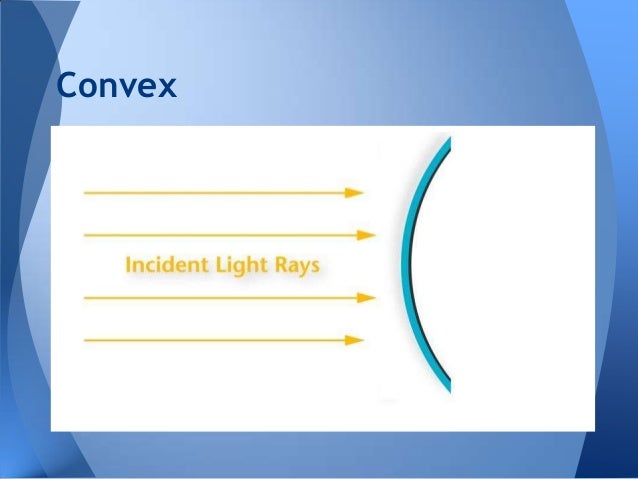
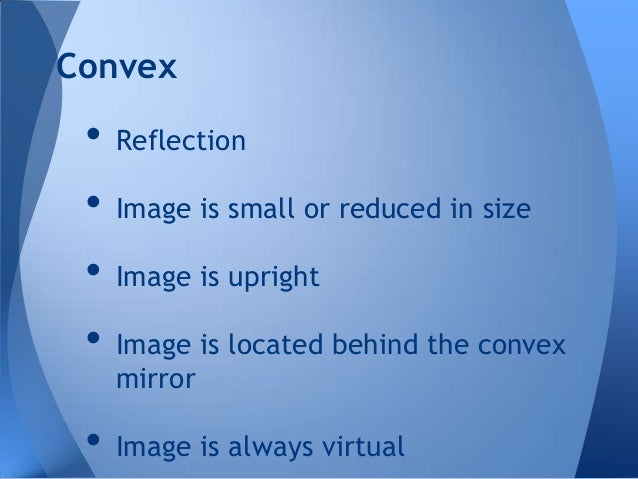

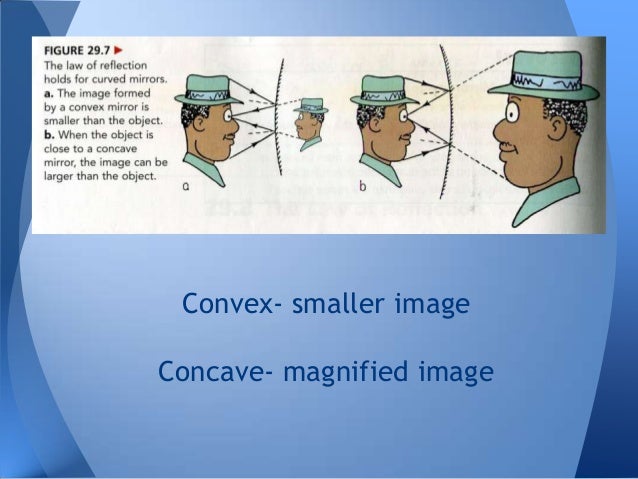

CONCAVE MIRROR
HINT : CONCAVE,It looks like a cave
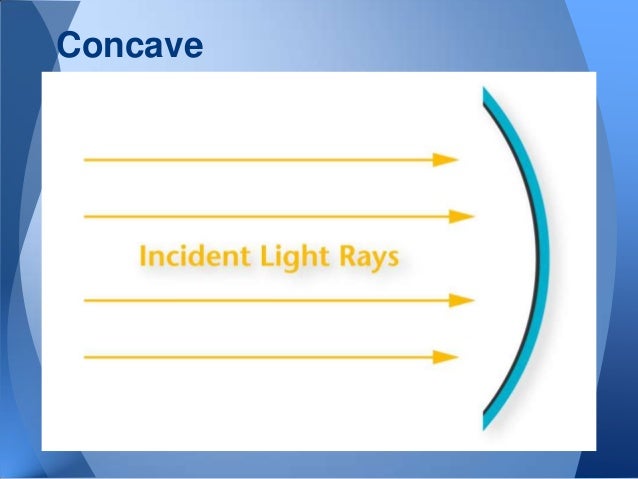
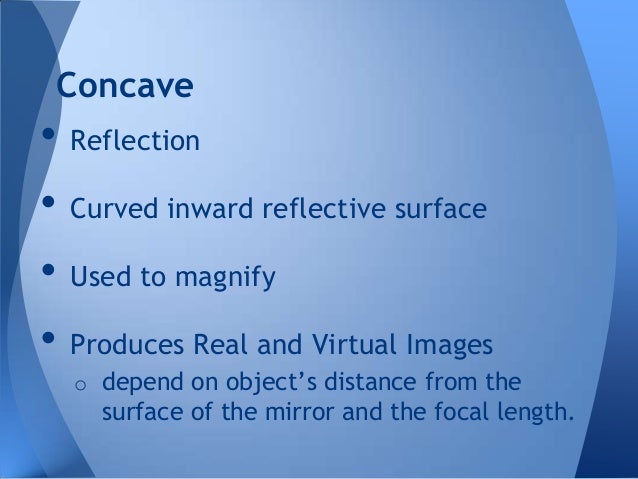

Friday 5 February 2016
Lunar and Solar Eclipse
What Is an Eclipse?
- An eclipse takes place when one heavenly body such as a moon or planet moves into the shadow of another heavenly body.
- There are two types of eclipses on Earth:
- An eclipse of the moon(Lunar Eclipse) and
- An eclipse of the sun(Solar Eclipse)
What Is a Lunar Eclipse?
- Sometimes Earth moves between the sun and the moon. When this happens, Earth blocks the sunlight that normally is reflected by the moon. (This sunlight is what causes the moon to shine.) Instead of light hitting the moon’s surface, Earth's shadow falls on it. This is an eclipse of the moon -- a lunar eclipse.
- A lunar eclipse can occur only when the moon is full.
- A lunar eclipse can be seen from Earth at night. There are two types of lunar eclipses: total lunar eclipses and partial lunar eclipses.
- A total lunar eclipse occurs when the moon and the sun are on exact opposite sides of Earth. Although the moon is in Earth's shadow, some sunlight reaches the moon. The sunlight passes through Earth's atmosphere, which causes Earth’s atmosphere to filter out most of the blue light. This makes the moon appear red to people on Earth.
- A partial lunar eclipse happens when only a part of the moon enters Earth's shadow. In a partial eclipse, Earth's shadow appears very dark on the side of the moon facing Earth. What people see from Earth during a partial lunar eclipse depends on how the sun, Earth and moon are lined up.
- A lunar eclipse usually lasts for a few hours. At least two partial lunar eclipses happen every year, but total lunar eclipses are rare. It is safe to look at a lunar eclipse.
 |
| Various stages of Lunar Eclipse |

What Is a Solar Eclipse?
- Sometimes when the moon orbits Earth, it moves between the sun and Earth.When this happens, the moon blocks the light of the sun from reaching Earth. This causes an eclipse of the sun, or solar eclipse. During a solar eclipse, the moon casts a shadow onto Earth.
- There are three types of solar eclipses.
- Total solar eclipse. A total solar eclipse is only visible from a small area on Earth. The people who see the total eclipse are in the center of the moon’s shadow when it hits Earth. The sky becomes very dark, as if it were night. For a total eclipse to take place, the sun, moon and Earth must be in a direct line.
- Partial solar eclipse. This happens when the sun, moon and Earth are not exactly lined up. The sun appears to have a dark shadow on only a small part of its surface.
- Annular solar eclipse. An annular eclipse happens when the moon is farthest from Earth. Because the moon is farther away from Earth, it seems smaller. It does not block the entire view of the sun. The moon in front of the sun looks like a dark disk on top of a larger sun-colored disk. This creates what looks like a ring around the moon.
- During a solar eclipse, the moon casts two shadows on Earth. The first shadow is called the umbra (UM bruh). This shadow gets smaller as it reaches Earth. It is the dark center of the moon’s shadow. The second shadow is called the penumbra (pe NUM bruh). The penumbra gets larger as it reaches Earth. People standing in the penumbra will see a partial eclipse. People standing in the umbra will see a total eclipse.
- Solar eclipses happen once every 18 months. Unlike lunar eclipses, solar eclipses only last for a few minutes.
- NEVER look directly at the sun: It can permanently damage your eyes! You must use proper safety equipment to look at any type of solar eclipse.
Comparison chart
| Lunar Eclipse | Solar Eclipse | |
|---|---|---|
| Health risk | Safe to look at moon during eclipse | Retina gets damaged if Sun seen directly with a naked eye |
| Position of Earth and Moon | Earth lies between the Sun and Moon | Moon lies between Sun and Earth |
| Types | Penumbral, partial, total or horizontal | Total, annular, hybrid, partial |
| Occurrence | At night | During day time |
| Frequency of occurrence | Twice a year or more | A few every year, total being less frequent |
| Visibility | Moon completely obscured, visible partially or in an orangish hue –visible from all night time places | Sun gets blocked by moon – eclipse visible only in some areas |
| Duration | A few hours | Usually a few minutes |
Monday 1 February 2016
What is Potential and Kinetic Energy
- Kinetic energy is energy possessed by a body by virtue(Behaviour) of its movement.
- Potential energy is the energy possessed by a body by virtue of its position or state.
- While kinetic energy of an object is relative to the state of other objects in its environment, potential energy is completely independent of its environment.

- Stored energy is called ‘potential energy’ and moving energy is called ‘kinetic energy’.
EXAMPLES


Sunday 31 January 2016
IMPORTANT DAMS IN INDIA
Important dams in India
Brief details of the important dams in India such as the Tehri Dam, Bhakra Dam, Hirakud Dam, Indira Sagar Dam, Nagarjuna Sagar dam, and Mettur dam is given below:
The Tehri Dam at Tehri in Uttarakhand which lies on the Bhagirathi River in India holds the rank of highest dam in India and one of the tallest dams in World. The Tehri Dam was built in the year 2006 with 1000 MW of hydro power generation capacity. It’s water is also used in the Municipal water supply and in irrigation works in the state of Uttarakhand. The Tehri dam is a 855 ft high rock and its length is 1886 ft, crest width of 66 ft and base width of 3701 ft which creates 2.6 cubic km of reservoir.
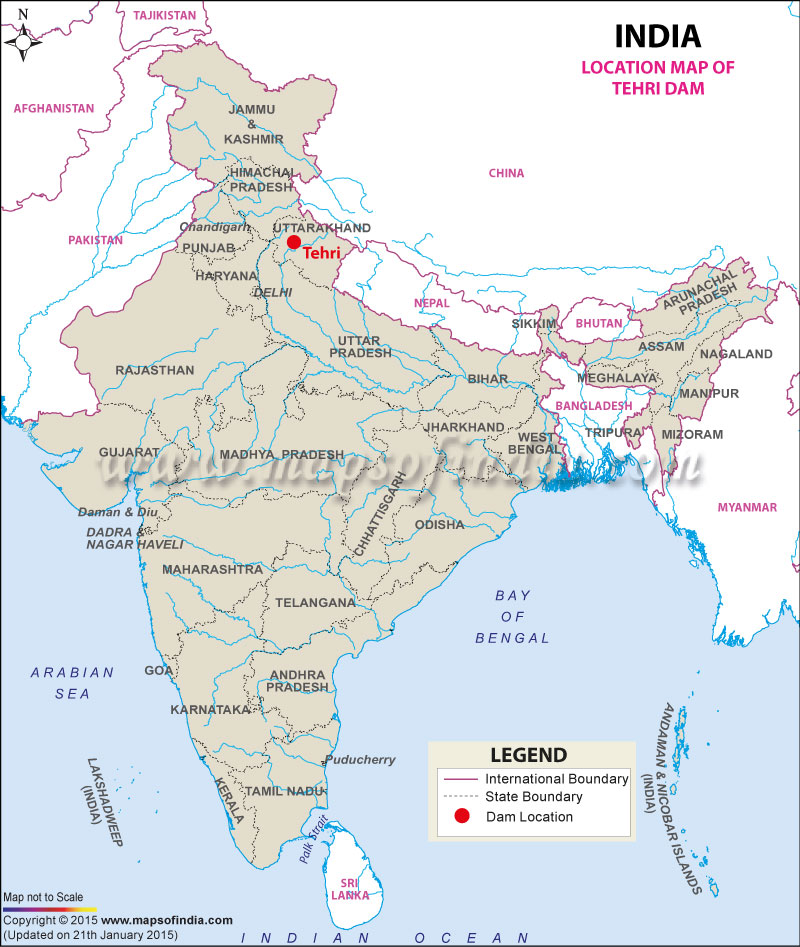

The Bhakra dam is across the Sutlej River. It was described as “New Temple of Resurgent India” by Pandit Jawaharlal Nehru who was the first prime minister of independent India. The Bhakra Dam is in the village of Bhakra in Himachal Pradesh of India. It was built in the year 1963. There is an another dam called Nangal in the downstream of Bhakra and both were called as Bhakra Nangal Dam. The Bhakra dam is at 740 ft tall which is next to the Tehri Dam, so it is the 2nd highest dam in India. The Bhakra dam is also the 2nd largest reservoir with capacity of 9.34 billion M3 after the Indira Sagar Dam in the state of Madhya Pradesh.
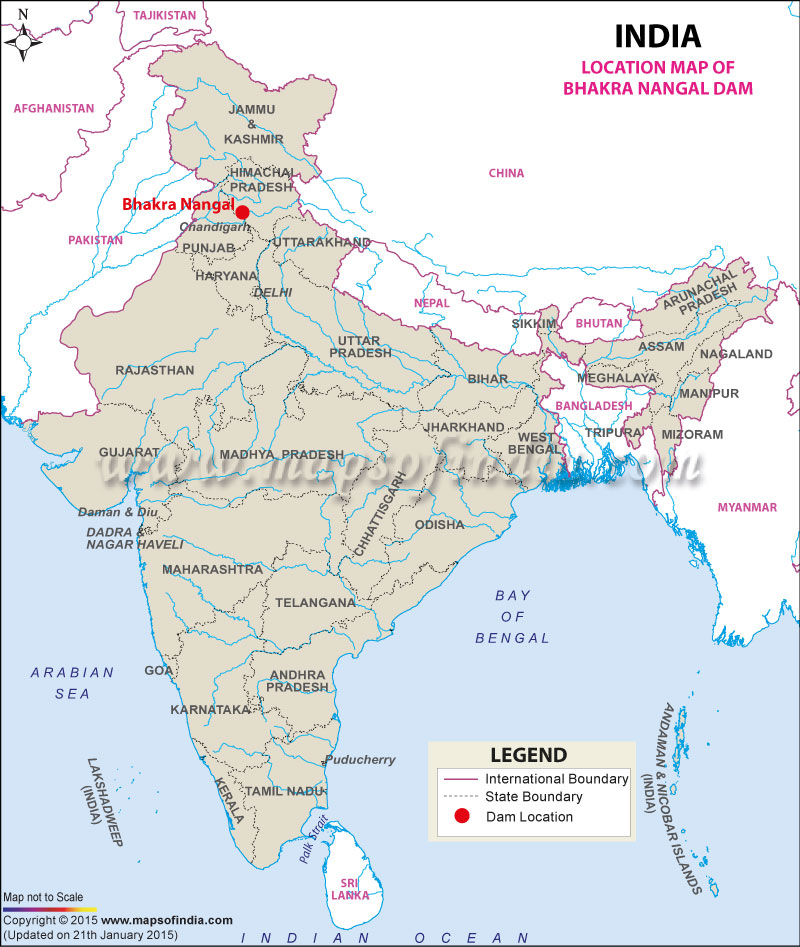

The Hirakud Dam was built in the year 1953 across the Mahanadi River in Hirakud district in Odisha. The Hirakud Dam was build for multipurpose use as Irrigation, Hydro Electricity generation etc. This dam has the installed hydro-power generation capacity of 307.5 MW. This dam is also saves the entire Mahanadi delta from flood. Hirakud dam’s length is 25.8 KM with an artificial lake of 743 sq K.M. which is the Asia’s biggest artificial lake.
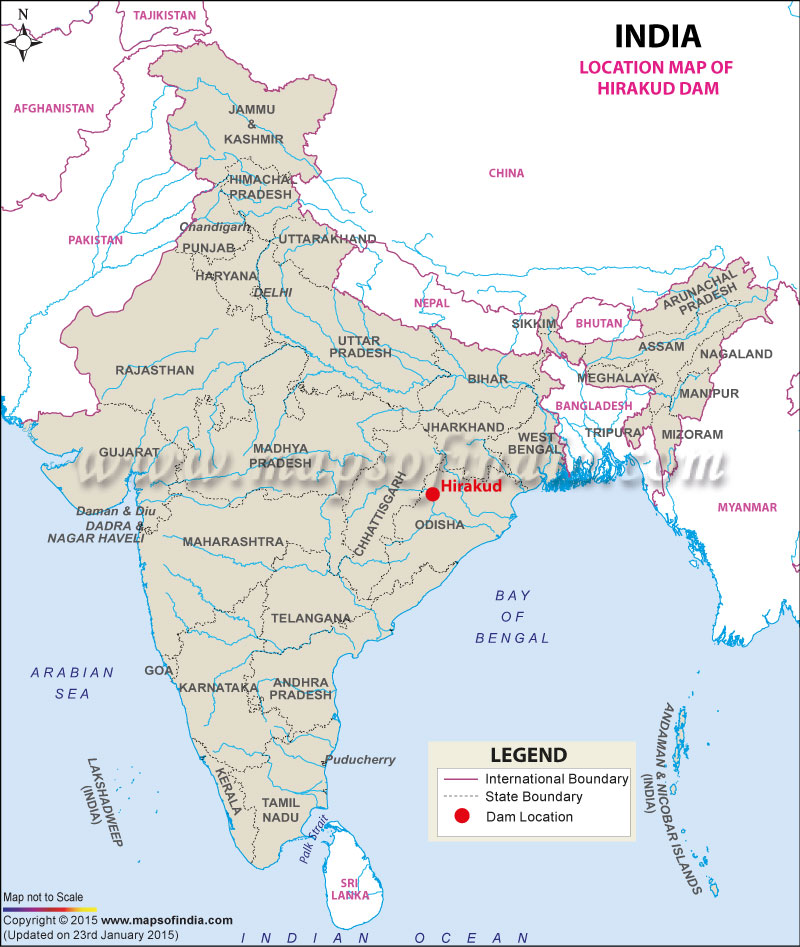

The Indirasagar Dam is built accross the Narmada river which is the India’s 5th largest river, at Narmadanagar in the district of Khandwa in Madhya Pradesh, was commissioned in the year 2005. This dam holds the 1st position as largest reservoir with installed capacity of 12.22 billion M3 in India. The Indirasagar dam has 1000 MW of hydro power installed capacity. This dam serves as a multipurpose dam like Hirakud, Bhakra Nangal dam etc.
The Nagarjuna Sagar dam was one of the earliest large Infra-projects which is built across Krishna River in Andhra Pradesh in India. The Nagarjuna Sagar dam is 150 meter tall and 1600 meter long which has the installed capacity of 816 MW of Hydro-electricity in 8 power generation units. This dam has water reservoir capacity of 11472 million M3.
The Mettur dam which was one of the oldest and largest dams was built in the year 1934 in India. This dam built across the Kaveri River in Tamilnadu state. Mettur dam is situated at Salem district in Tamilnadu. The Mettur dam has the reservoir capacity of 94.3 billion cubic feet at height of 120 ft and length is at 1700 meters. The Mettur dam is utilised mainly in farm land irrigation works in the parts of Namakkal, Salem, Tiruchirapalli and district of Thanjavur.
Saturday 30 January 2016
Important Rivers in India
List of Important rivers in India
Important rivers in India
The rivers is played very important role in providing irrigation water, drinking water, electricity, easy & cheap transportation, other miscellaneous works has been done with the help of rivers.
The important rivers of India are Ganga, Yamuna, Brahmaputra, Indus, Mahanadi, Godavari, Krishna, Kauery, Narmada and Tapti. A brief description of these rivers is given below:


Ganga: Ganga is the most holy river according to Hindu. It has started from the Gangotri in the Himalayas and poured into the Bay of Bengal by travelling of around 2525 km. It is ranked 3rd largest river in the world. There are a number of cities had been developed across the banks of Ganga like Pataliputra, Kashi, Allahabad, Varanasi, Kolkata etc. It had also created the World’s largest delta in West Bengal named as Sundarban delta.
Yamuna: Yamuna River had originated from Yamunotri Glacier in the Himalayas, then travels across several states and merged into the Ganga at Triveni, Allahabad. Its total length is 1376 km. Yamuna River’s water contributed nearly 70% of Delhi’s water supply. The Taj Mahal is situated on the banks of Yamuna River.
Brahmaputra: Brahmaputra River is originated from Angsi Glacier, the northern Himalayas in Tibet(China), then entered into the Arunachal Pradesh to Assam and then merges with the Padma river in Bangladesh. Its length is around 2900 km and plays an important role in the irrigation and transportation. It emptied into the Bay of Bengal.
Indus River: The Indus River is a historically famous in Asia. It originated from the Tibetan Plateau, and then flows through the Ladakh then entered into Pakistan and finally merge into the Arabian Sea after travelling a distance of 3180 km.
Mahanadi River: Mahanadi is a major river in the state of Chhattisgarh and Odisha. Mahanadi’s water is used in the irrigation and drinking purpose, it is also called the ruin of Orissa due its devastating floods over the years but till Hirakud Dam was constructed. Its total length is 858 km.
Godavari: Godavari is the longest river in the southern India and 2nd largest in India after Ganga. It is originated from Maharashtra and flows through Andhra Pradesh, then merges into the Bay of Bengal after travelling a distance of 1465 km.
Krishna: The 3rd longest river in India after Ganga and Godavari, Krishna River which is originated from Mahabaleswar in Maharashtra and flows through the state of Karnataka, Andhra Pradesh and finally merges into the Bay of Bengal by travelling a distance of 1400 km.
Kaveri: The Kaveri River is one of the large rivers in India which is originated from Talakaveri in the Western Ghats of Karnataka and flows through the states of Karnataka & Tamilnadu, finally merges into Bay of Bengal by travelling a distance of 765 km.
Narmada: Narmada River is the 5th Longest in the Indian sub-continent. It is also called the Life line of Madhya pradesh due to its huge contributions. Narmada River is originated from Narmada Kund, Amarkantak in Madhya Pradesh and merges into the Arabian Sea near Gujarat after travelling a distance of 1312 km.
Tapti: Tapti River is one of the major rivers in Central India. Its total length is around 724 km which flows through the states of Gujarat, Madhya Pradesh and Maharashtra and finally merges into the Gulf of Cambay of Arabian Sea near Gujarat.
Rowlatt Act and Jallianwallah Bagh Massacre
Rowlatt Act, 1919
During the 1st World War, Indians started revolution and movements for forming self-Government. To subdue(To bring under control) these movements, the British Government formed the Rowlatt committee in 1919.The Rowlatt committee was named after Sydney Rowlatt, an English judge.
It was said in the report of this commission that:
(a) Nationalist newspapers should be banned.
(b) Just on suspicion, any Indian may be arrested and imprisoned for indefinite period and without any trial
Strong opposition was built up against this Anti-National Act. All the Indian members of the Central Law Committee raised their voices against this Act. Madanmohan Malavya, Mohammad Ali Jinnah, Mazhar ul Haque etc. resigned from the committee.
Jinnah said, “The fundamental principle of justice have been imported and the constitutional rights of the people have been unrooted at a time when there is no real danger to the state”.
Surendranath Banerjee and Gandhiji called for an all out movement against this Act. Amrita Bazar Patrika called this Black Act as a ‘gigantic blunder”. So nationwide strike was called by Gandhi on 30th March and 6th April 1919 A.D. Gandhiji sarcastically said “appeal nehi, ukil nehi, dalil nehi”, (there was no advocate, no appeal and no record). Gandhiji called the British rule “Satanism”. So historian Tarachand said, the transformation of a strong believer in non-violence like Gandhiji initiated the moral decline of the British Empire.
Jallianwala Bagh Massacre (Killings)
The British were threatened that this mass movement could break all lines of communications in the country and so they decided to suppress the nationalists. Several local leaders were arrested and Mahatma Gandhi was prohibited from entering Delhi.
On 13th April 1919 several villagers had gathered at the Jallianwalla Bagh in Amritsar(Punjab) to attend a cattle fair on the occasion of Baisakhi. General Dyer blocked all the entry points to the ground and without any prior warning, opened fire on the hapless crowd.
On 13th April 1919 several villagers had gathered at the Jallianwalla Bagh in Amritsar(Punjab) to attend a cattle fair on the occasion of Baisakhi. General Dyer blocked all the entry points to the ground and without any prior warning, opened fire on the hapless crowd.
As per the instruction of Dyer, four entrances were closed. After that the British soldiers started firing to the helpless throng the people with 50 rifles from a distance of hardly 100 years. They fired 1600 round of bullets within 10 minutes at a stretch. Many persons including children and women were killed and injured.
The merciless firing continued for 10-15 minutes leaving hundreds of people including women and children dead and wounded.
The Jallianwalla Bagh massacre triggered many protests, strikes, and clashes with policemen and attacks on Government buildings, across North India. The British Government suppressed these protests and humiliated the Satyagrahis.
The merciless firing continued for 10-15 minutes leaving hundreds of people including women and children dead and wounded.
The Jallianwalla Bagh massacre triggered many protests, strikes, and clashes with policemen and attacks on Government buildings, across North India. The British Government suppressed these protests and humiliated the Satyagrahis.
SWADESHI MOVEMENT
Swadeshi Movement: Timeline and Important facts that you must know
The Swadeshi Movement, now known as 'Make in India' campaign was officially proclaimed on August 7, 1905 at the Calcutta Town Hall, in Bengal. Boycott movement was also launched along with the Swadeshi movement. The movements included using goods produced in India and burning British-made goods.. Bal Gandadhar Tilak encouraged Swadeshi and Boycott movement after the British government decided the partition of Bengal.
Timeline of Swadeshi movement:
- In 1900, Bengal was the major province in British India. The Indian national movement began in Bengal and thus, Britishers decided to part Bengal.
- When Lord Curzon, then Viceroy of India, announced the partition of Bengal in July 1905, Indian National Congress, initiated Swadeshi movement in Bengal. Swadeshi movement was launched as a protest movement which also gave a lead to the Boycott movement in the country.
- In 1909, the movement had spread across the country and people had started anti-partition and anti-colonial movements. In Andhra Pradesh, the Swadeshi movement was also known as Vandemataram movement
- In 1910, there were many secret associations that had been set up and there were many revolutionary movements, which were synonymous to Swadeshi movement
- Later movements by Mahatma Gandhi from 1915, such as Satyagraha movement, Non-Cooperation movement etc. were based on Swadeshi movement.
L. M. Bhole identifies five phases of the Swadeshi movement.
- 1850 to 1904: developed by leaders like Dadabhai Naoroji, Gokhale, Ranade, Tilak, G.V. Joshi.
- 1905 to 1917: Began with, and because of the partition of Bengal in 1905 by Lord Curzon.
- 1918 to 1947: Swadeshi thought shaped by Mahatma Gandhi, accompanied by the rise of Indian industrialists.
- 1948 to 1991: Widespread curbs on international and inter-state trade. India became a bastion of obsolete technology during the licence-permit raj.
- 1991 onwards: liberalization and globalization. Foreign capital, foreign technology, and many foreign goods are not excluded and doctrine of export-led growth resulted in modern industrialism.
Bal Gangadhar Tilak
Bipin Chandra Pal
Lala Lajpat Rai
Aurobindo Ghosh
VO Chidambaram Pillai
Babu Genu
Summary
The Swadeshi and Boycott movements were started to oppose the Partition of Bengal.
The Boycott movement
The idea of boycott was started after the failure of peaceful campaigns and petitions. Rabindranath Tagore and Ramendra called for the observance of Raksh Bandhan and Arandhan on the day of the partition.
The Swadeshi movement
This movement also started to oppose the partition of Bengal. ‘Swadeshi’ means of one’s own country according to this people should use goods produced within the country. This was lead by Lala Lajpat Rai, Bipin Chandra Pal and Bal Gangadhar Tilak, in the year 1905. Swadeshi movement received the support of the youth.
Spread of the Movements
British goods were burnt at public places. The youth of Bengal took active part in the movements. Women gave up the use of glass utensils and stopped wearing foreign bangles. Use of foreign paper was refused by Students. Foreign goods like sugar and cloth were not allowed to use. Those who didn't take part in this movement were socially boycotted.
Results of Boycott Movement
The Charkha which was a spinning wheel represented the country’s economic self-sufficiency.
This encouraged purchasers to buy native produced goods thereby boycotting British goods
Results of Swadeshi Movement
- Hindus and Muslims Cooperated
- Youth were ready to sacrifices.
- Social barriers like class and creed disappeared
- The press became fear less.
- The unity among the people increased.
Nationalism
Lord Curzon intended to bring in differences among the Indians with the partition of Bengal, but they were against him. The movements encouraged nationalism and patriotism.
Native Industries
The movement contributed to the growth of native industries such as textile mills, match and soap factories, tanneries and potteries. Formation of banks and insurance companies too grew during this period.
Cultural Life
The culture of the National poetry and prose by great Indian writers such as Rabindranath Tagore, Mukunda Dass and RajaniKanta Sen had a great impact on Indians. Political journalism that resulted from the movements gave an impulse to freedom, liberty and self-reliance.
Education
National educational institutions were opened for imparting literacy, technical and physical education. The International University at Shantiniketan was one of them which was founded by Tagore in Bengal.
Mode of protests
People’s sacrifice and new mode of protest were to be seen all over. Thousands of people were arrested and sent to jail. Peaceful processions were subjected to lathi charges. New mode of protests like hartals, picketing, demonstration on roads, boycott of goods and institutions became part and parcel of Indian national movements.
Subscribe to:
Posts (Atom)












